Abstract
A competitive antibody-binding assay (CABA) was developed to detect antibodies in infected armadillos and leprosy patients which compete with an M. leprae-specific 125I monoclonal antibody IIIE9 for the species-specific M. leprae-IIIE9 epitope on the 65-kD protein. The results suggest armadillos and leprosy patients produce antibodies that inhibit the binding of 125I-IIIE9 monoclonal antibody to the IIIE9 epitope on crude, native 65-kD protein preparations. When purified, recombinant 65-kD protein was substituted for crude antigen, there was no evidence in the CABA of antibody to the IIIE9 epitope. False-positive results, possibly induced by steric hindrance, are likely to be associated with CABA which incorporate crude cell wall extracts as solid-phase antigen.
Full text
PDF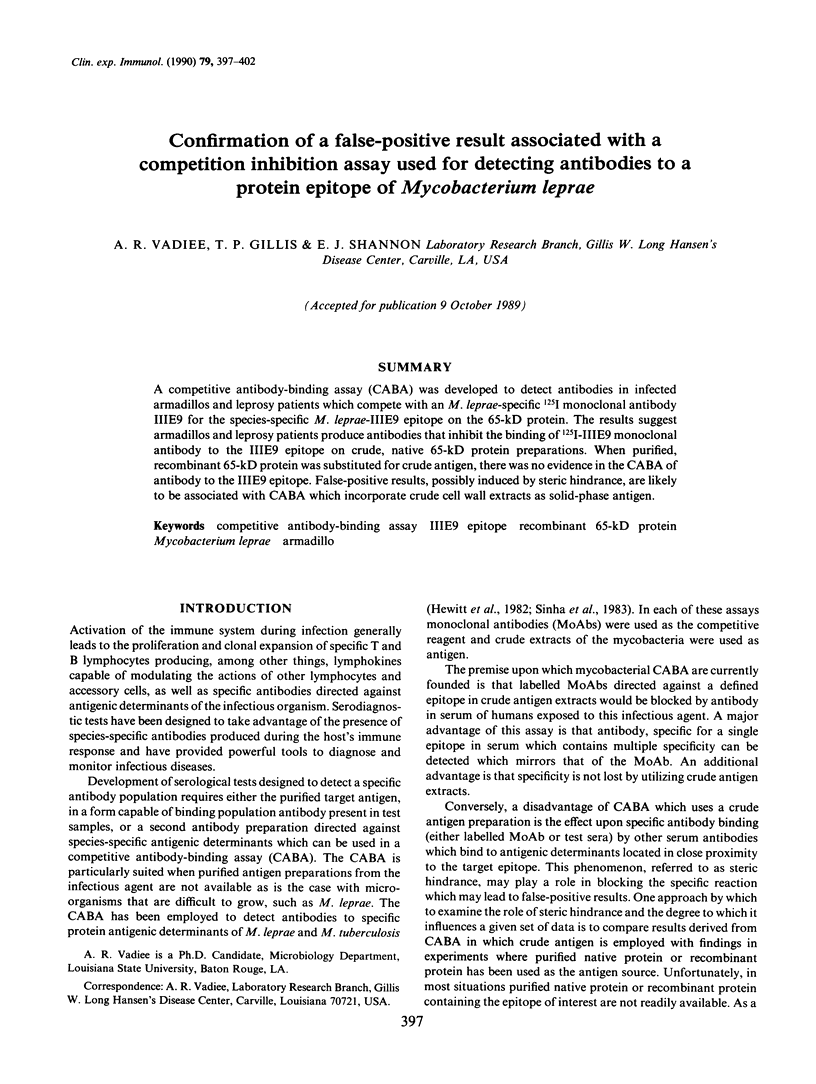
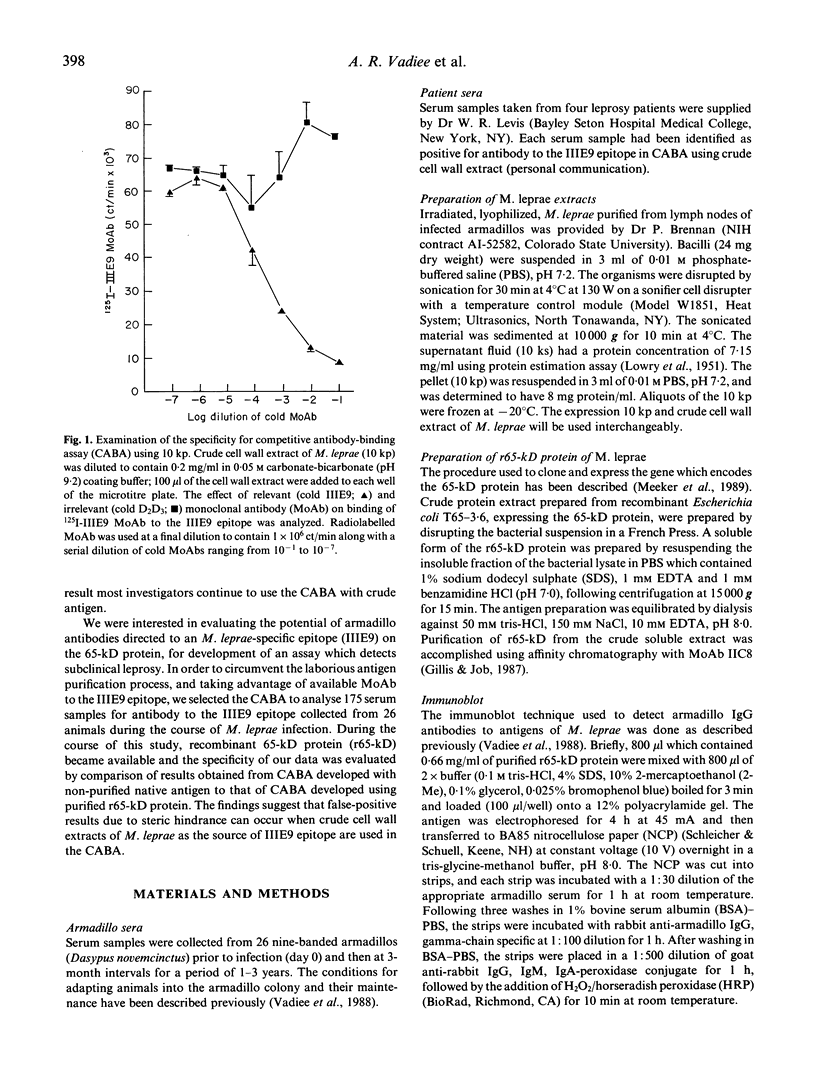
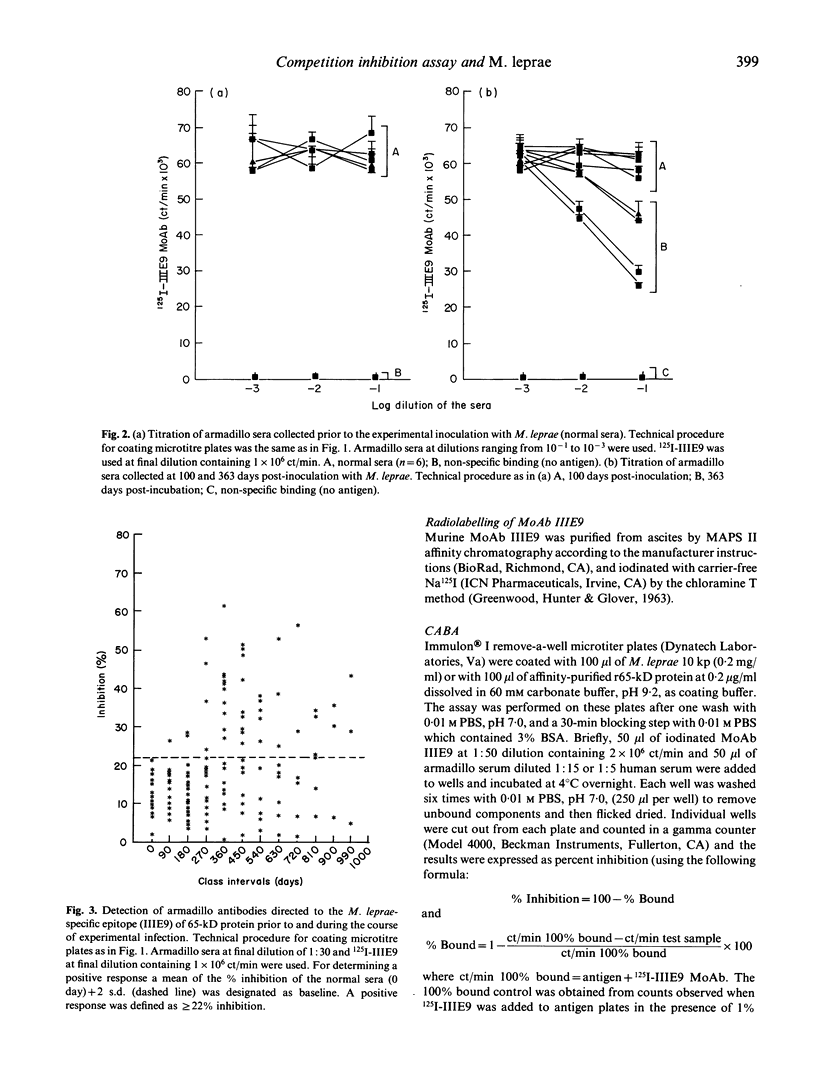
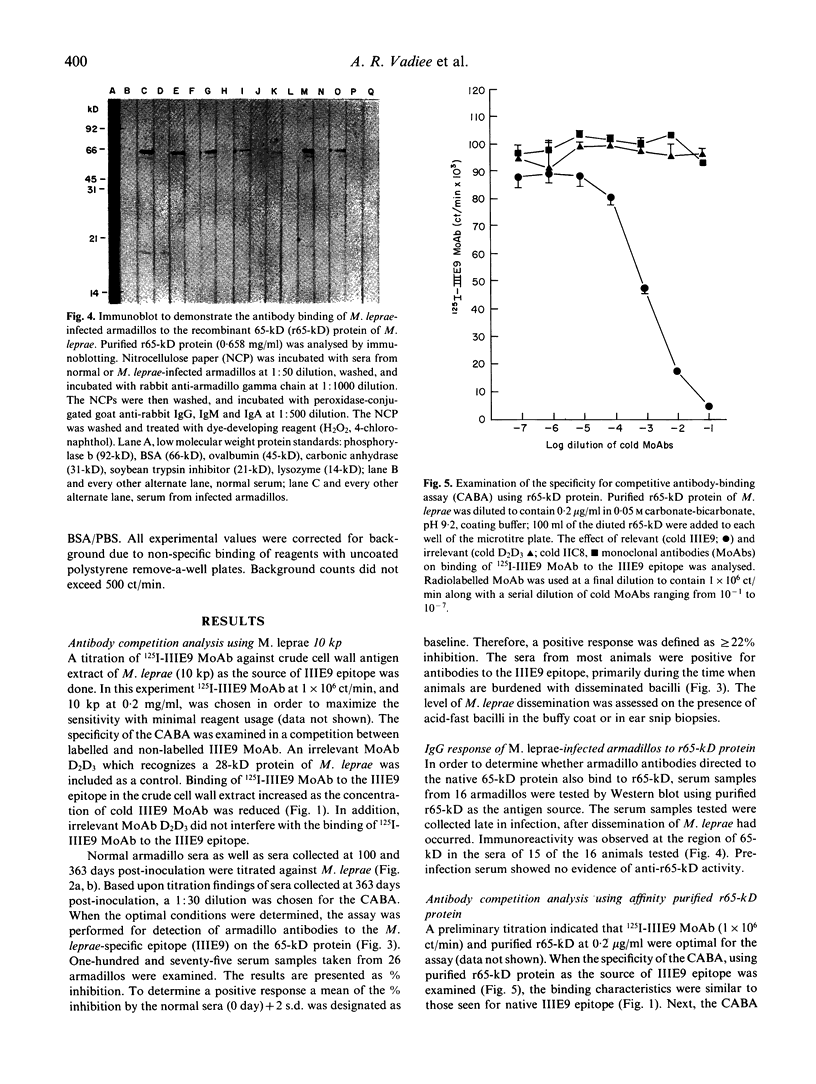
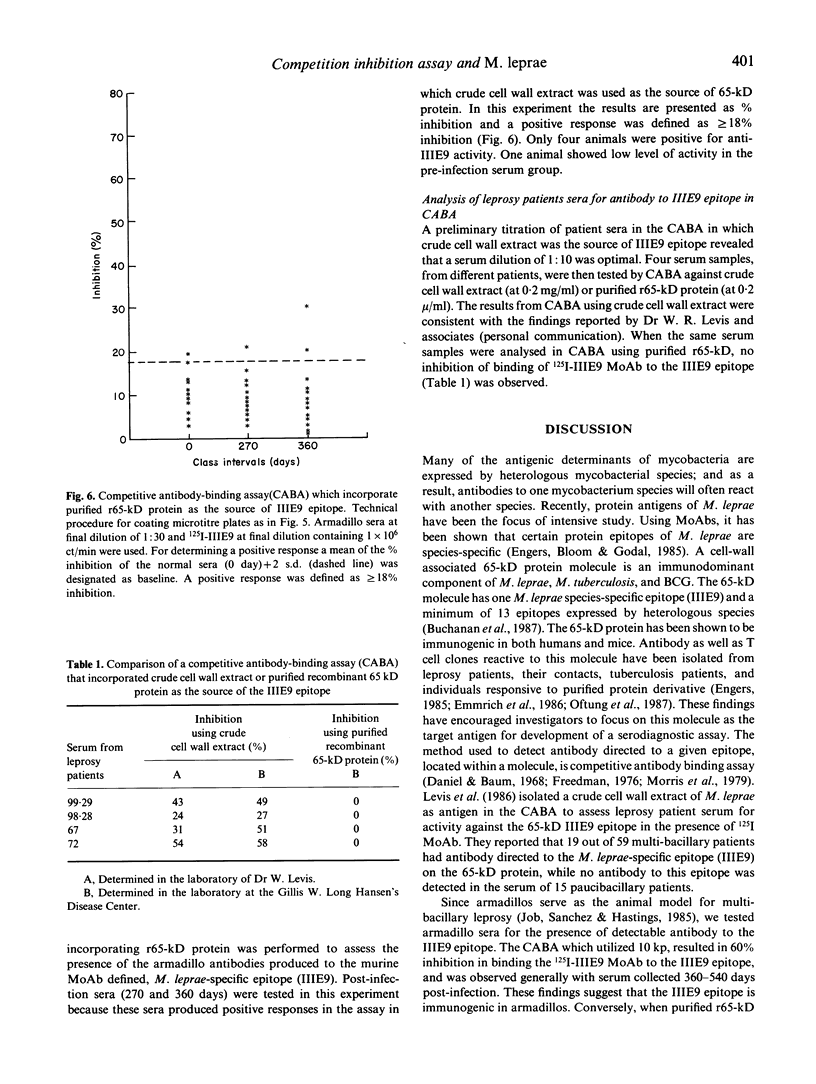

Images in this article
Selected References
These references are in PubMed. This may not be the complete list of references from this article.
- Buchanan T. M., Nomaguchi H., Anderson D. C., Young R. A., Gillis T. P., Britton W. J., Ivanyi J., Kolk A. H., Closs O., Bloom B. R. Characterization of antibody-reactive epitopes on the 65-kilodalton protein of Mycobacterium leprae. Infect Immun. 1987 Apr;55(4):1000–1003. doi: 10.1128/iai.55.4.1000-1003.1987. [DOI] [PMC free article] [PubMed] [Google Scholar]
- Chakrabarty A. K., Maire M. A., Lambert P. H. SDS-PAGE analysis of M. leprae protein antigens reacting with antibodies from sera from lepromatous patients and infected armadillos. Clin Exp Immunol. 1982 Sep;49(3):523–531. [PMC free article] [PubMed] [Google Scholar]
- Daniel T. M., Baum G. L. The immunoglobulin response to tuberculosis. I. Molecular characterization of hemagglutinating antibody to tuberculopolysaccharide in sera from patients with tuberculosis. Am Rev Respir Dis. 1968 Oct;98(4):677–680. doi: 10.1164/arrd.1968.98.4.677. [DOI] [PubMed] [Google Scholar]
- Emmrich F., Thole J., van Embden J., Kaufmann S. H. A recombinant 64 kilodalton protein of Mycobacterium bovis bacillus Calmette-Guerin specifically stimulates human T4 clones reactive to mycobacterial antigens. J Exp Med. 1986 Apr 1;163(4):1024–1029. doi: 10.1084/jem.163.4.1024. [DOI] [PMC free article] [PubMed] [Google Scholar]
- GREENWOOD F. C., HUNTER W. M., GLOVER J. S. THE PREPARATION OF I-131-LABELLED HUMAN GROWTH HORMONE OF HIGH SPECIFIC RADIOACTIVITY. Biochem J. 1963 Oct;89:114–123. doi: 10.1042/bj0890114. [DOI] [PMC free article] [PubMed] [Google Scholar]
- Gillis T. P., Job C. K. Purification of the 65 kD protein from Mycobacterium gordonae and use in skin test response to Mycobacterium leprae. Int J Lepr Other Mycobact Dis. 1987 Mar;55(1):54–62. [PubMed] [Google Scholar]
- Hewitt J., Coates A. R., Mitchison D. A., Ivanyi J. The use of murine monoclonal antibodies without purification of antigen in the serodiagnosis of tuberculosis. J Immunol Methods. 1982 Dec 17;55(2):205–211. doi: 10.1016/0022-1759(82)90032-1. [DOI] [PubMed] [Google Scholar]
- Job C. K., Sanchez R. M., Hastings R. C. Manifestations of experimental leprosy in the armadillo. Am J Trop Med Hyg. 1985 Jan;34(1):151–161. doi: 10.4269/ajtmh.1985.34.151. [DOI] [PubMed] [Google Scholar]
- LOWRY O. H., ROSEBROUGH N. J., FARR A. L., RANDALL R. J. Protein measurement with the Folin phenol reagent. J Biol Chem. 1951 Nov;193(1):265–275. [PubMed] [Google Scholar]
- Levis W. R., Meeker H. C., Schuller-Levis G. B., Gillis T. P., Marino L. J., Jr, Zabriskie J. Serodiagnosis of leprosy: relationships between antibodies to Mycobacterium leprae phenolic glycolipid I and protein antigens. J Clin Microbiol. 1986 Dec;24(6):917–921. doi: 10.1128/jcm.24.6.917-921.1986. [DOI] [PMC free article] [PubMed] [Google Scholar]
- Meeker H. C., Williams D. L., Anderson D. C., Gillis T. P., Schuller-Levis G., Levis W. R. Analysis of human antibody epitopes on the 65-kilodalton protein of Mycobacterium leprae by using synthetic peptides. Infect Immun. 1989 Dec;57(12):3689–3694. doi: 10.1128/iai.57.12.3689-3694.1989. [DOI] [PMC free article] [PubMed] [Google Scholar]
- Morris J. A., Stevens A. E., Stuart P., Little T. W. A pilot study to assess the usefulness of ELISA in detecting tuberculosis in badgers. Vet Rec. 1979 Jan 6;104(1):14–14. doi: 10.1136/vr.104.1.14. [DOI] [PubMed] [Google Scholar]
- Oftung F., Mustafa A. S., Husson R., Young R. A., Godal T. Human T cell clones recognize two abundant Mycobacterium tuberculosis protein antigens expressed in Escherichia coli. J Immunol. 1987 Feb 1;138(3):927–931. [PubMed] [Google Scholar]
- Results of a World Health Organization-sponsored workshop on monoclonal antibodies to Mycobacterium leprae. Infect Immun. 1985 May;48(2):603–605. doi: 10.1128/iai.48.2.603-605.1985. [DOI] [PMC free article] [PubMed] [Google Scholar]
- Sinha S., Sengupta U., Ramu G., Ivanyi J. A serological test for leprosy based on competitive inhibition of monoclonal antibody binding to the MY2a determinant of Mycobacterium leprae. Trans R Soc Trop Med Hyg. 1983;77(6):869–871. doi: 10.1016/0035-9203(83)90309-7. [DOI] [PubMed] [Google Scholar]
- Vadiee A. R., Shannon E. J., Gillis T. P., Hastings R. C. Partial characterization of antigens from M. leprae evoking IgG and IgM antibodies in armadillos. Int J Lepr Other Mycobact Dis. 1988 Jun;56(2):274–282. [PubMed] [Google Scholar]



